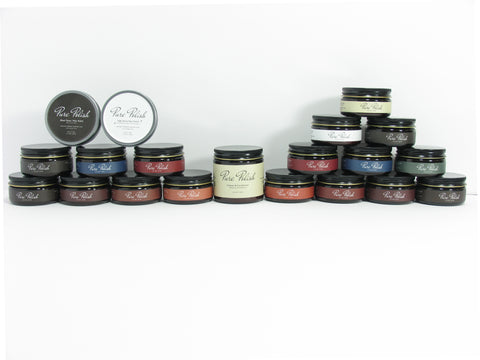What Goes Into Leather Polish?
We were asked this question in a comment on the Goodyear Welt Subreddit recently, and thought we'd elaborate a bit more about what goes into polish in-general, as well as what we specifically add to ours – ie. what makes Pure Polish special.
All leather polish must have four basic ingredients:
- Solvent: usually Naphtha or Turpentine
- Oil: usually Neatsfoot (bovine tallow) or Mink oil
- Wax: usually Beeswax and/or Carnauba Wax
- Color: usually chemical dyes
Solvent has two main purposes:
- Soften and ease the spread of the polish
- Dissolve and clean the old waxes.
Wax has four main purposes:
- Cosmetic, for adding a shine.
- Protection, so that if you scuff your shoe on something, you aren’t scuffing the leather, just the wax.
- Color stabilization. It allows you to replenish or change the color of the leather, as it is what holds the dye or pigment, rather than applying dye or pigment directly to the leather.
- Proportion moderation. It is mixed at a proportion determined by the manufacturer to provide conditioning, protection, and/or shine. Can you condition your leather without wax, using oil only? Yes, but you run the risk of over conditioning. Wax helps you moderate that proportion through other application/textural limiters (you could spread cream on very thick, but it will usually get over-sticky before getting over saturated).
Can polish be made without conditioning oil? Yes, that’s usually a High Shine or Mirror Gloss Product, designed for maximum cosmetic appeal.
Can polish be made without solvent? Yes, but then you’re using other products like borax to soften the wax.
Can polish be made without wax? Conditioner can. But again, you are limiting your protection, running the risk of over application, and coloring the leather directly.
Can Polish be made without color? Yes, that’s Neutral, High Shine, or Cleaner/Conditioner type products.
Pure Polish Difference
Our products contain only the following all natural, non-toxic, pleasant smelling ingredients:
Solvent –

We use food grade orange terpenes (d-Limonene). Orange oil contains the raw oil collected from the citrus peel during the juicing extraction process. Once orange oil has been extracted from the rind, d-Limonene is separated from sesquiterpenes, other monoterpenes, and is purified by high vacuum distillation to produce food grade d-Limonene. The orange citric acid has a pH value of approximately 3.5, similar to the pH value of vegetable tanned leather which is approximately 3.2 (chrome tanned leather has a pH of approximately 3.8).
Orange oil contains citric acid and ascorbic acid, both of which are preventative antioxidants, and assist in oxidative stability. Orange oil is considered a volatile oil because it evaporates relatively quickly (over a few hours) when exposed to air (not in a closed container); this allows it to act as a solvent, rather than a lubricant like coconut oil. Pure Polish will last well over a year, if the jar is only open during use (this is true of any shoe polish).
Oil –

We use organic extra-virgin coconut oil. Coconut oil is about 50 percent lauric acid, a rare medium-chain fatty acid, and is studied for its anti-fungal, anti-viral, and anti-bacterial properties. Overall, coconut oil contains 92% saturated fats (mink oil contains about 80% saturated fats). Saturated fat percentage is a major factor in determining oxidative stability; the higher the saturated fat percentage is the higher the oxidative stability (See Iodine Value below).
Coconut oil has a neutral pH balance (7.0), similar to mink oil (6.5).
Wax –

Our Beeswax is one of the most natural wax products available. Beeswax is the wax made by honeybees intended for the protection of their honeycombs. The main components in beeswax are palmitate, palmitoleate, and oleate esters of long-chain (30-32 carbons) aliphatic alcohols, with a ratio of 6:1 of triacontanyl palmitate to cerotic acid, the two principal components.

The Carnauba wax we use is a natural vegetable wax exuded by the leaves of a palm tree (copernicia cerifera) growing in Brazil. It is the hardest natural wax available, composed of wax esters (85%), free fatty acids, fatty alcohols and resins (15%). Our Carnauba wax is basically odorless.
Color –

We use Earth and Ocher pigments for our coloring. All of our coloring is safe, non-toxic, environmentally friendly, and free from chromium, cadmium, mercury, tin, arsenic, radium, lead or other hazardous materials.
Our Products

View our catalog, to see the assortment of products we make from these ingredients.

Stephen – We do not offer classes on polish making, as it’s proprietary to our own products. This is about as in-depth as we go. But your enthusiasm is appreciated!
G – I haven’t heard of anything regarding orange terpenes being bad for cotton. It’s not typically used on cotton – more for leather & vinyl cleaning. I’ll have to leave that question unanswered, as I don’t have a satisfactory answer.
Your products are amazing, so glad there’s somewhere to get shoe care products that only contain natural ingredients. I have a pair of cotton canvas and leather shoes, is orange oil terpenes damaging to the cotton?
Hi Andy, great job. I’d like to know if you offer lecture/tutorial on how to make these amazing craft? I’m really interested in learning.
Hi Keith – Your comment got mixed in with SPAM, so apologies for my latent reply. I believe I emailed you directly about this, recommending our neutral products (Cleaner Conditioner, Neutral Cream, High Shine) to maintain the beautiful natural patina. But, if I didn’t fully answer your questions, feel free to email me here. Thanks!
Hi I have some chrome tanned and oiled leather shoes what do you recommend for cleaning conditioning and polish. Thanks keith